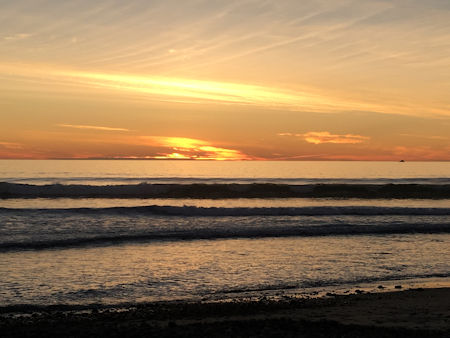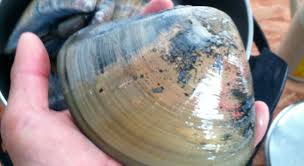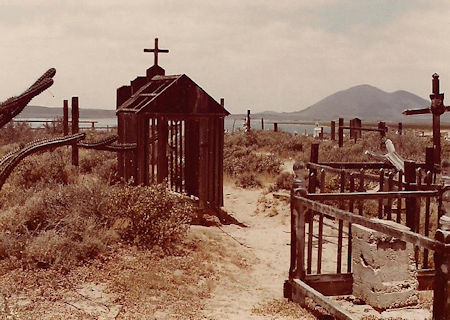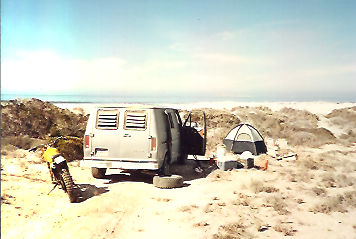 |  |
By Greg Niemann

Instead of prairie schooners, horses and wagons, our three vans formed the circle around our camp’s outer perimeter. Assorted tables and boxes comprised the inner circle. The campfire dominated the center and provided us with fuel for preparing dinner, warmth, and a setting for social interaction during the cool, damp nights.
Often in summer a marine layer dominates the fertile San Quintín valley, billowing in off the Pacific in a thick moist soup. And when it clears, the wind might howl for three or four days at a time, adding thousands more grains of sand to the sensuous sculpture of broad dunes that line the beaches. Between the extremes are many days of perfection: sunny and warm summer days, cloudless, royal blue skies and soft, comfortable nights.
Back in the mid-1980s, Cantamar neighbors Don and Marie with their guest Mary, along with Erv and Sally, joined me and Leila for the excursion. Our vans formed a caravan from Cantamar (10 miles south of Rosarito) to this simple Baja of an earlier era, yet only 120 miles south of Ensenada.
The dirt road from Highway 1 to the ocean dunes was a bit sandy but only one of our vans got stuck. We were able to tow it out and continue on to the beach.
As we neared the broad beach, large clam shells from many decades littered the dirt road. We found a high, hard-packed area just inland from the big sand dunes which we agreed would be perfect for our campsite.
The broad Santa Maria beach
The wide, sandy Santa Maria beach, a mile or so south of the La Pinta Hotel at San Quintín was a haven for big perch and Pismo clams. I remembered a week spent on that beach when I was a child in the 1940s, and had been back several times in my Jeep on exploring expeditions. Enamored with the area, I wanted to return to spend more time, and our neighbors were eager to see more of Baja.

As we neared, some Americans passed us leaving the beach on the dirt road. Bronzed from the sun, they could have passed for locals were it not for their trailer full of motorcycles and other assorted gringo toys. As if changing the guard, we stopped and exchanged greetings. They had figuratively passed the baton onto us as they wearily made for the highway.
After that we saw no other countrymen all week.
The only visitors while we were there were a handful of men and women from the village. They would arrive on a mule cart at optimum low tide, even as early as 4:30 a.m., and leave an hour later with gunny sacks bulging with Pismo clams.
Our days were usually spent venturing beyond our makeshift home on that hard-packed earth. We had to constantly wend our way through a pass in the sand dunes to the ocean.
We too joined the locals by going clamming almost daily during the hour of low tide. We waded in ankle-deep water and jabbed our pitchforks into the sand. Hitting a hard object was hitting paydirt, for there were no rocks on this beach. In about an hour we would each unearth 8-10 large, succulent Pismo clams.
The days were languid. We swam, enjoyed the sun, and wandered the beach searching for marine and crustacean artifacts as well as man-made debris. Singly, in couples or in small groups, we hiked the sand dunes and explored the area.
The Old English Cemetery
One day I took everyone to the Old English Cemetery where surnames still visible on the weathered wooden crosses revealed a decidedly Anglican heritage. These marked the deceased members of the 200 or so English colonists who tried to tame the land about 100 years previous, only to have their dreams dashed by drought.

On previous visits to the area, I’d wandered around the cemetery, fascinated by the unlikely chapter of Baja history when between 1880 and 1889 Mexico invited foreigners to colonize there, offering lots at attractive land terms.
The International Company, run by Americans, hired hackers including my great-grandfather Bascom A. Stephens, at the time a San Diego journalist, to promote the charms of the San Quintín area. Even so, they attracted few settlers and eventually sold the enterprise to an English company.
The English company, hoping to attract 1,000 settlers, started to develop the land, digging wells, dredging the harbor, building a pier, and planning a railroad. Unfortunately, the 200 who did settle the valley were devastated by a lengthy drought, ending that early enterprise.
A century later, the vast San Quintín Valley is fertile and productive. Large growers regularly supply U.S. markets with truckloads of tomatoes, corn, and chiles.
I still liked exploring the remnants of that early endeavor and chuckled recalling how in the 1970s my little MGB was once stuck in the sand there. A decade later with my CJ-5 Jeep I definitely had much better Baja-road success.
Another time I’d seen a rattlesnake slither away from a pitahaya cactus whose spines sprawled across several graves.
Our group moved from marker to marker, noting the short lives of some of the colonists, reflecting on the hardship of these adventurous foreigners. It was an interesting and reflective experience.
Large Barred Perch
Back in camp, we fished from the surf, catching the largest barred surf perch I’d ever seen. They were weighing several pounds and were so large, Don and I released perch larger that anything either of us had ever caught at Cantamar.
In fact, Tom Miller, in his book Angler’s Guide to Baja California wrote, “Nowhere in its range are the barred perch any bigger, or more plentiful, than along the beaches which extend about 20 miles in both directions from the community of San Quintín.”
In the evenings we made clam dip, clam chowder, fried clam strips, and raw clams to supplement the fish. Don was always experimenting, making tasty treats from our bounty directly from the sea. One night he made an outstanding ceviche from some perch.
And at night, under a twinkling canopy of brilliant stars set against a velvet black sky, we’d sit around the fire telling tall tales and ribald jokes. As the week wound down we planned to come again.
Our campsite was gone!

The next year a couple more people joined our group for another trip to the Santa Maria beach. But the same narrow dirt road to those sand dunes was now surprisingly an improved road that took us to a built-up area. A large cyclone fence surrounded a wide area behind the dunes, including our old hard-packed campsite. A new sign indicated that this was now Honey’s Trailer Park and Campground, complete with concrete slabs, showers, and – people.
It was a huge disappointment for us as we wanted to recapture that blissful summer week sans civilization and we knew Honey’s wouldn’t cut it for us.
As everyone looked at me, I was really glad then that my Jeep reconnoitering of past years had offered me options. I’d remembered another dirt road which we then followed behind the dunes for about a mile until we found a large flat spot where we again pulled our vans into a social circle.
It was the same, but not the same. While we were denied our former idyllic campsite, we continued to catch record perch and fill our sacks with delicious clams. The newcomers among us loved it as well.
About Greg
Greg Niemann, a long-time Baja writer, is the author of Baja Fever, Baja Legends, Palm Springs Legends, Las Vegas Legends, and Big Brown: The Untold Story of UPS. Visit www.gregniemann.com.

Baja Bound is and has been my go to Mexico insurance company. The website is extremely easy to...

It was simple to purchase coverage and feeling that I was protected.